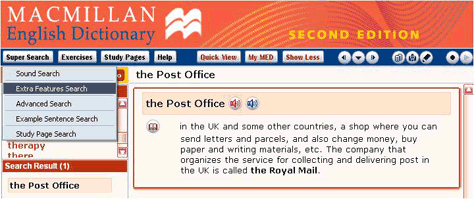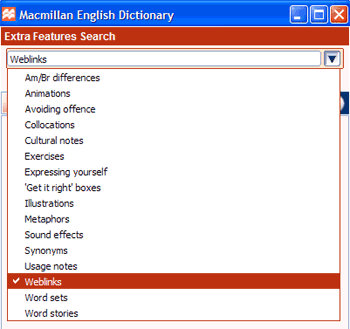MED Magazine - Issue 46 - August 2007
Beyond the definition
Weblinks and the Macmillan English Dictionary
by Mairi MacDonald
• Introduction
• Which definitions contain weblinks?
• What value do websites add to definitions?
• Why include weblinks?
The new edition of the Macmillan English Dictionary contains many useful features such as notes on British and American English and information panels describing the etymology of a word. This extra information appears in both the book and CD-ROM versions of the Dictionary. Other features such as animations and sound effects are found only on the CD-ROM. The multimedia nature of electronic dictionaries means that in addition to reading about a word, learners can hear how it is pronounced, see an image, play a sound effect or watch an animation.
To help learners get even more out of a definition, the
MED CD-ROM includes over 1200 weblinks. Clicking on the button ![]() at the
end of a definition will take you directly to a website related to that
word. By tapping into the vast resources of the Internet, the CD-ROM goes
one step further in exploiting the multimedia capabilities that an electronic
dictionary can offer.
at the
end of a definition will take you directly to a website related to that
word. By tapping into the vast resources of the Internet, the CD-ROM goes
one step further in exploiting the multimedia capabilities that an electronic
dictionary can offer.
Which definitions contain weblinks?
Any entry that has a suitable website relating to the definition or headword can have a weblink. It is important that the websites linking from the definitions are well-designed and provide a good example of authentic English. An appropriate website doesn't exist for all definitions and the best candidates are entries that refer to cultural information such as the Bloomsbury Group, Mrs Beeton, Carry-on film, the Boston tea party. Companies (eg BT), government agencies (CIA, FBI) organisations (the AA, TUC) tend to have good websites, as do brand names and products (Band-Aid, Marmite).
If you want to find all the definitions containing weblinks, click on Super Search in the top left corner of the Dictionary.

Select Extra Features Search, followed by Weblinks from the drop-down
menu.

Click on Go and you will see a list of all the weblinks in the Dictionary.
What value do websites add to definitions?
Websites can give an instant visual illustration of a definition. This is particularly useful for definitions relating to art and architecture. Clicking on the weblinks for Art Nouveau, Gothic and conceptual art instantly takes the user to a visual example of these terms. A computer screen is the natural place to see an example of ASCII art. A picture of the Forth rail bridge should help learners understand and visualise the phrase like painting the Forth bridge.
Some sites go beyond simply illustrating or describing a definition in more detail and provide concrete examples of the word in question. The link at webzine for example, leads you to the webzine you’re currently reading - after all it is better to see a webzine in action than read an explanation. The weblink at hangman gives learners the option of playing the actual word game. The site linked to ACT (American College Test) has practice questions as well as advice on sitting the test. The Internet can add an extra dimension to definitions; if students want to know more about the song Auld Lang Syne, the weblink takes them to a site containing not only the lyrics with translations of the Scottish words, but also gives them the option of singing along. Learners looking up English breakfast can try it out for themselves by following the instructions given on the featured website.
Websites, by their nature, encourage learners to read further. A well-designed site has to be easy to navigate and attractive to persuade visitors to read on. A learner clicking on the link at MI5 can read about it in great detail if they so chose, explore its history or even apply for a job!
The Internet can provide detailed information that is beyond the scope of a learner dictionary. For example, medical terms can be explained in much greater detail by a specialist website. If you want to find out more about Aussie Rules the official site explains all you could possibly need to know about the sport. One of the great features of the web is the seemingly limitless amount of space - the website that links from the entry for Frankenstein’s monster leads to an online version of the entire novel by Mary Shelley.
Finally a good website is continually updated. While the occupants of No. 10 (Downing Street) and the White House come and go, there‘s no need to wait for a reprint to get the latest information - the sites that link from these definitions will always refer to the current resident.
The websites listed on the CD-ROM are already freely accessible on the Internet so why bother to include weblinks if users can find the sites for themselves?
The Internet is an incredible source of information but anyone who has spent time searching the Web will know that you sometimes have to dig deep to find what you want. The weblinks on the CD-ROM take users directly to the best site without wasting time or getting sidetracked.
If a learner doesn’t fully understand a definition, they might end up at the wrong site; sometimes you need to know what a word means before you can find the best site. An internet search on gherkin wouldn’t distinguish between a type of pickle (gherkin) and the famous London skyscraper (the Gherkin)
The English part of the web can be a difficult and confusing place if it isn't your first language. Sometimes a site that seems OK at first glance can turn out to be unsuitable - it might be biased or have inappropriate content. Some sites are poorly written, unedited or obscured by advertising. A native-speaker level of English is required to weed these out.
The weblinks offer relevant supplementary information that learners can explore at their own pace, encouraging them to develop their reading skills. As well as extended reading practice, students stay focused on the definition they are looking up, as the weblinks take them directly to the best site. This saves time and cuts out misleading search results.
A good site will help users understand a definition and the extra dimension that the Internet can bring will reinforce what they have learnt. Students should be able to retain the meaning and hopefully be in a better position to use the word productively.
Copyright © Macmillan Publishers Limited 2007
This webzine is brought to you by Macmillan Education